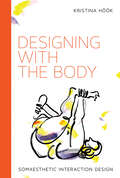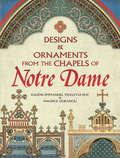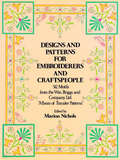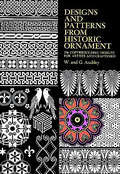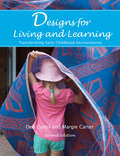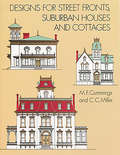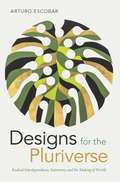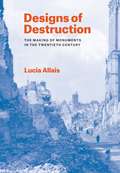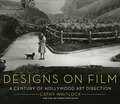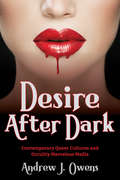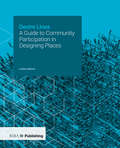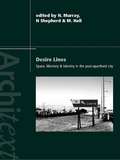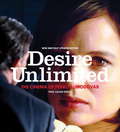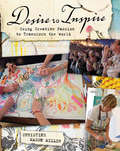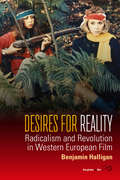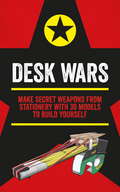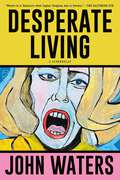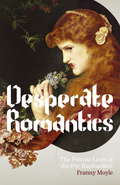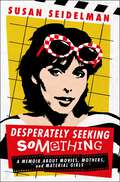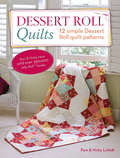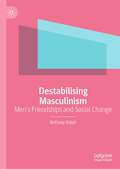- Table View
- List View
Designing with the Body: Somaesthetic Interaction Design (Design Thinking, Design Theory)
by Kristina HookInteraction design that entails a qualitative shift from a symbolic, language-oriented stance to an experiential stance that encompasses the entire design and use cycle. With the rise of ubiquitous technology, data-driven design, and the Internet of Things, our interactions and interfaces with technology are about to change dramatically, incorporating such emerging technologies as shape-changing interfaces, wearables, and movement-tracking apps. A successful interactive tool will allow the user to engage in a smooth, embodied, interaction, creating an intimate correspondence between users' actions and system response. And yet, as Kristina Höök points out, current design methods emphasize symbolic, language-oriented, and predominantly visual interactions. In Designing with the Body, Höök proposes a qualitative shift in interaction design to an experiential, felt, aesthetic stance that encompasses the entire design and use cycle. Höök calls this new approach soma design; it is a process that reincorporates body and movement into a design regime that has long privileged language and logic. Soma design offers an alternative to the aggressive, rapid design processes that dominate commercial interaction design; it allows (and requires) a slow, thoughtful process that takes into account fundamental human values. She argues that this new approach will yield better products and create healthier, more sustainable companies. Höök outlines the theory underlying soma design and describes motivations, methods, and tools. She offers examples of soma design “encounters” and an account of her own design process. She concludes with “A Soma Design Manifesto,” which challenges interaction designers to “restart” their field—to focus on bodies and perception rather than reasoning and intellect.
Designing: A Journey Through Time
by Jacques R. GiardDesigning: A Journey Through Time uses the metaphor of a journey to explore how designing as an ongoing human activity has evolved over time and place.
Designs and Ornaments from the Chapels of Notre Dame (Dover Pictorial Archive Ser.)
by Eugene-Emmanuel Viollet-le-Duc Maurice OuradouArchitect and theorist Eugene-Emmanuel Viollet-le-Duc (1814–79), a prominent leader in the French Gothic Revival, was active in the restoration of medieval buildings. In 1845 he undertook one of the greatest projects in the history of restoration: the cleansing and restoration of the Cathedral of Notre-Dame in Paris. For the next twenty-three years he labored at his task, returning the cathedral to its original beauty and charm.This volume is based on a faithful reproduction of the restored mural paintings of the chapels, notable for their originality of design and the soft and subtle harmony of their coloring. The 60 full-page plates lend themselves to numerous graphic arts applications.
Designs and Patterns for Embroiderers and Craftspeople
by Marion Nichols William Briggs Co.Have you ever wanted to create your own embroidery and crewel designs but given up the idea just because you can't draw? Here is a book containing over 500 patterns and designs from the finest Victorian source. Just transfer the designs to cloth, select a color scheme, use your favorite stitches, and soon your very own personal "noodle painting" will begin to form.These designs are classified according to type so that they are easier for you to use. You will find large motifs for big areas and dainty motifs for smaller projects; borders (narrow, medium, and wide) for pillows, sheets, and anything wanting a decorative edge; centers and corners for tablecloths and upholstery; insects, birds, and flowers for adding color to shirts and jeans; and even scenes perfect for sewing and framing.A wide variety of flowers, sprays, and greenery is included in this book, usually in various combinations: daisies, tulips, peonies, dahlias, cornflowers, lilies, rosebuds, poppies, violets, and forget-me-nots, plus shamrocks, heather, and flowers with ribbons, in baskets, etc. There are also butterflies, bluebirds, bumblebees, owls, dragonflies, and insects of all sorts. For those whose tastes are more unconventional or avant-garde, there are geometric designs, dramatic sunbursts, and unusual beasts.Complete instructions explain how to transfer these designs to cloth, and imaginative crafters will find this book suitable to a variety of other media, including metalwork, woodwork leather craft, and more.
Designs and Patterns from Historic Ornament (Dover Pictorial Archive)
by W. And AudsleyThis well-known book was prepared a century ago by two British architects, and its reputation has grown steadily since. The Audsleys' rendering of designs from a wide variety of sources are national traditions, and their excellent sense of space and proportion and their straightforward interpretations of these ornaments have made this collection among the most valuable of its kind.The 60 plates contain over 250 large-scale line drawings, mostly executed by the authors. The designs and patterns shown are derived from architectural decorative motifs, textile designs, patterns from ceramics, etc. A brief text specifies sources for many of the designs, and captions identify national origin and often the original color schemes.The illustrations include ancient Egyptian patterns from painted tomb ceilings, borders from Greek vases, Celtic designs, Japanese ornaments, Moorish decorations, eleventh-century Italian textile designs, and architectural elements from the cathedral of Notre-Dame and other buildings.This partial list of contents gives an idea of the many styles of design reproduced in the book, and the applications to which the designs can be put. Commercial artists, architects, crafters, designers, scene designers, and others will find these pages a rich source of decorative designs.
Designs for Living and Learning, Second Edition
by Deb Curtis Margie CarterYou likely have dreams for your early childhood environment that are greater than rating scales, regulations, and room arrangements. Designs for Living and Learning has been a favorite resource among educators and caregivers for more than a decade, and this new edition is packed with even more ideas that can be used as you create captivating environments that nurture children, families, and staff while supporting children's learning. With hundreds of all-new colorful photographs of real early learning settings and a multitude of simple and practical concepts for creative indoor and outdoor spaces and learning materials, this book truly is a source of inspiration as you learn how to shape welcoming spaces where children can learn and grow.Expanded chapters include new information reflecting current trends and concerns in early childhood, such as the use of repurposed and nontraditional materials, children in the outdoors, alternative ways to think about providing for learning outcomes, facing and overcoming barriers and negotiating change, and the impact of environmental rating scales in Quality Rating and Improvement Systems (QRIS). Two new chapters are included, one highlighting the transformations of environments with before and after photos and outlines of the process, and the other with examples of soliciting children's ideas about the environment.Deb Curtis and Margie Carter are internationally acclaimed experts in early childhood. They host three-day institutes and professional development seminars for early childhood professionals; consult with early childhood programs across North America, Australia, and New Zealand; and have written many books together.
Designs for Street Fronts, Suburban Houses and Cottages (Dover Architecture)
by C. C. Miller M. F. CummingsExcellent sourcebook includes elevations of building fronts as well as enlarged drawings of architectural elements incorporated in these facades: residential entrances, cornices, a curved roof, dormer window, and much more. Indispensable archive for preservationists, restorationists, architectural historians, and urban archaeologists. 714 illustrations on 52 plates.
Designs for the Pluriverse: Radical Interdependence, Autonomy, and the Making of Worlds (New Ecologies for the Twenty-First Century)
by Arturo EscobarIn Designs for the Pluriverse Arturo Escobar presents a new vision of design theory and practice aimed at channeling design's world-making capacity toward ways of being and doing that are deeply attuned to justice and the Earth. Noting that most design—from consumer goods and digital technologies to built environments—currently serves capitalist ends, Escobar argues for the development of an “autonomous design” that eschews commercial and modernizing aims in favor of more collaborative and placed-based approaches. Such design attends to questions of environment, experience, and politics while focusing on the production of human experience based on the radical interdependence of all beings. Mapping autonomous design’s principles to the history of decolonial efforts of indigenous and Afro-descended people in Latin America, Escobar shows how refiguring current design practices could lead to the creation of more just and sustainable social orders.
Designs of Destruction: The Making of Monuments in the Twentieth Century
by Lucia AllaisThe twentieth century was the most destructive in human history, but from its vast landscapes of ruins was born a new architectural type: the cultural monument. In the wake of World War I, an international movement arose which aimed to protect architectural monuments in large numbers, and regardless of style, hoping not only to keep them safe from future conflicts, but also to make them worthy of protection from more quotidian forms of destruction. This movement was motivated by hopeful idealism as much as by a pragmatic belief in bureaucracy. An evolving group—including architects, intellectuals, art historians, archaeologists, curators, and lawyers—grew out of the new diplomacy of the League of Nations. During and after World War II, it became affiliated with the Allied Military Government, and was eventually absorbed by the UN as UNESCO. By the 1970s, this organization had begun granting World Heritage status to a global register of significant sites—from buildings to bridges, shrines to city centers, ruins to colossi. Examining key episodes in the history of this preservation effort—including projects for the Parthenon, for the Cathedral of St-Lô, the temples of Abu Simbel, and the Bamyian Buddahs —Lucia Allais demonstrates how the group deployed the notion of culture to shape architectural sites, and how architecture in turn shaped the very idea of global culture. More than the story of an emergent canon, Designs of Destruction emphasizes how the technical project of ensuring various buildings’ longevity jolted preservation into establishing a transnational set of codes, values, practices. Yet as entire nations’ monumental geographies became part of survival plans, Allais also shows, this paradoxically helped integrate technologies of destruction—from bombs to bulldozers—into cultural governance. Thus Designs of Destruction not only offers a fascinating narrative of cultural diplomacy, based on extensive archival findings; it also contributes an important new chapter in the intellectual history of modernity by showing the manifold ways architectural form is charged with concretizing abstract ideas and ideals, even in its destruction.
Designs on Film: A Century of Hollywood Art Direction
by Cathy Whitlock The Art Directors GuildWho can forget the over-the-top, white-on-white, high-gloss interiors through which Fred Astaire danced in Top Hat? The modernist high-rise architecture, inspired by the work of Frank Lloyd Wright, in the adaptation of Ayn Rand's The Fountainhead? The lavish, opulent drawing rooms of Martin Scorsese's The Age of Innocence? Through the use of film design—called both art direction and production design in the film industry—movies can transport us to new worlds of luxury, highlight the ornament of the everyday, offer a vision of the future, or evoke the realities of a distant era. In Designs on Film, journalist and interior designer Cathy Whitlock illuminates the often undercelebrated role of the production designer in the creation of the most memorable moments in film history. Through a lush collection of rare archival photographs, Whitlock narrates the evolving story of art direction over the course of a century—from the massive Roman architecture of Ben-Hur to the infamous Dakota apartment in Rosemary's Baby to the digital CGI wonders of Avatar's Pandora.Drawing on insights from the most prominent Hollywood production designers and the historical knowledge of the venerable Art Directors Guild, Whitlock delves into the detailed process of how sets are imagined, drawn, built, and decorated. Designs on Film is the must-have look book for film lovers, movie buffs, and anyone looking to draw interior design inspiration from the constructions and confections of Hollywood. Whitlock lifts the curtain on movie magic and celebrates the many ways in which art direction and set design allow us to lose ourselves in the diverse worlds showcased on the big screen.
Desire After Dark: Contemporary Queer Cultures and Occultly Marvelous Media
by Andrew J. OwensSince the 1960s, the occult in film and television has responded to and reflected society's crises surrounding gender and sexuality.In Desire After Dark, Andrew J. Owens explores media where figures such as vampires and witches make use of their supernatural knowledge in order to queer what otherwise appears to be a normative world. Beginning with the global sexual revolutions of the '60s and moving decade by decade through "Euro-sleaze" cinema and theatrical hardcore pornography, the HIV/AIDS crisis, the popularity of New Age religions and witchcraft, and finally the increasingly explicit sexualization of American cable television, Owens contends that occult media has risen to prominence during the past 60 years as a way of exposing and working through cultural crises about queerness. Through the use of historiography and textual analyses of media from Bewitched to The Hunger, Owens reveals that the various players in occult media have always been well aware that non-normative sexuality constitutes the heart of horror's enduring appeal. By investigating vampirism, witchcraft, and other manifestations of the supernatural in media, Desire After Dark confirms how the queer has been integral to the evolution of the horror genre and its persistent popularity as both a subcultural and mainstream media form.
Desire Lines: A Guide to Community Participation in Designing Places
by Lesley MaloneDesire lines are the paths that people create through regular usage. They appear where people repeatedly choose to walk and usually signify a route from A to B that’s quicker than the formal path provided. In most cases they indicate the mismatch between what local people want and what designers think people want. By employing some social research basics in the design development process, placemakers can work more meaningfully with local communities to meet their needs and aspirations. This is a practical guide to running public consultations, co-design and community engagement to help practitioners make the most of local knowledge and insight for the benefit of design. It offers guidance on managing community participation, and unapologetically aims to encourage designers to start thinking like social researchers when they undertake these programmes. It’s intended for placemakers - architects, urban designers, landscape architects, and other built environment professionals involved in the planning and design of public realm - who want to develop more people-centred, community-led design approaches.
Desire Lines: Space, Memory and Identity in the Post-Apartheid City (Architext)
by M. Hall N. Murray N ShepherdThis ground breaking new work draws together a cross-section of South African scholars to provide a lively and comprehensive review of the under-researched area of heritage practice following the introduction of the National Heritage Resources Act. Looking at the daily heritage debates, from naming streets to projects such as the Gateway to Robben Island, Desire Lines addresses the innovative strategies that have emerged in the practice of defining, identifying and developing heritage sites. In a unique multi-disciplinary approach, contributions are featured from a broad spectrum of fields, including the built environment and public culture and education. Showcasing work from tour operators and museum curators alongside that of university-based scholars, this book is a comprehensive and singularly authoritative volume that charts the development of new and emergent public cultures in post-apartheid South Africa through the making and unmaking of its urban spaces. This pioneering collection of essays and case studies is an indispensable guide for those working within or studying heritage practice.
Desire Unlimited
by Paul Julian SmithIn the last decade, Spanish auteur Pedro Almodóvar has grown from critical darling of the film circuit scene to mainstream success. Frequently comic, often deadly serious, always visually glorious, his recent films range from the Academy Award-winning drama Talk to Her to the 2011 horror film The Skin I Live In. Though they are ambitious and varied in style, each is a distinctive innovation on the themes that have defined his work. Desire Unlimited is the classic film-by-film assessment of Almodóvar's oeuvre, now updated to include his most recent work. Still the only study of its kind in English, it vigorously confirms its original argument that beneath Almodóvar's genius for comedy and visual pleasure lies a filmmaker whose work deserves to be taken with the utmost seriousness.From the Hardcover edition.
Desire and Excess: The Nineteenth-Century Culture of Art
by Jonah SiegelIn this fascinating look at the creative power of institutions, Jonah Siegel explores the rise of the modern idea of the artist in the nineteenth century, a period that also witnessed the emergence of the museum and the professional critic. Treating these developments as interrelated, he analyzes both visual material and literary texts to portray a culture in which art came to be thought of in powerful new ways. Ultimately, Siegel shows that artistic controversies commonly associated with the self-consciously radical movements of modernism and postmodernism have their roots in a dynamic era unfairly characterized as staid, self-satisfied, and stable.The nineteenth century has been called the Age of the Museum, and yet critics, art theorists, and poets during this period grappled with the question of whether the proliferation of museums might lead to the death of Art itself. Did the assembly and display of works of art help the viewer to understand them or did it numb the senses? How was the contemporary artist to respond to the vast storehouses of art from disparate nations and periods that came to proliferate in this era?Siegel presents a lively discussion of the shock experienced by neoclassical artists troubled by remains of antiquity that were trivial or even obscene, as well as the anxious aesthetic reveries of nineteenth-century art lovers overwhelmed by the quantity of objects quickly crowding museums and exhibition halls. In so doing, he illuminates the fruitful crises provoked when the longing for admired art is suddenly satisfied. Drawing upon neoclassical art and theory, biographies of early nineteenth-century writers including Keats and Scott, and the writings of art critics such as Hazlitt, Ruskin, and Wilde, this book reproduces a cultural matrix that brings to life the artistic passions and anxieties of an entire era.
Desire to Inspire: Using Creative Passion to Transform the World
by Christine Mason Miller Tonia DavenportEmbody your passion, share your creative gifts, impact the greater good. In Desire to Inspire, you'll meet a wide range of writers, artists and entrepreneurs, all with a common mission: to make an impact in the world, share her message and encourage others to inspire those around them. You'll get personal insight into the creative passions of artists like Carmen Torbus, Pixie Campbell, Christen Olivarez, Tracey Clark and so many more! 10 chapters address a universal need for artists to have a meaningful impact in the world through the making and sharing of art. Includes inspiring stories and art from 20 high-profile artists and provides examples to get your own ideas stirring. 20 engaging exercises help you discover your own strengths, goals and potential paths to inspire others and make as big an impact as the contributors. 20 inspirational quotes (on two full-color pages, printed on heavier cardstock) to create your Inspiration Deck. Let Desire to Inspire fuel your creative passions and start making a big impact today!
Desires for Reality: Radicalism and Revolution in Western European Film
by Benjamin HalliganAs with many aspects of European cultural life, film was galvanized and transformed by the revolutionary fervor of 1968. This groundbreaking study provides a full account of the era's cinematic crises, innovations, and provocations, as well as the social and aesthetic contexts in which they appeared. The author mounts a genuinely fresh analysis of a contested period in which everything from the avant-garde experiments of Godard, Pasolini, Schroeter, and Fassbinder to the "low" cinematic genres of horror, pornography, and the Western reflected the cultural upheaval of youth in revolt-a cinema for the barricades.
Desires of Credit in Early Modern Theory and Drama: Commerce, Poesy, and the Profitable Imagination (Studies in Performance and Early Modern Drama)
by Brian SheerinDesires of Credit in Early Modern Theory and Drama traces the near-simultaneous rise of economic theory, literary criticism, and public theater in London at the turn of the seventeenth century, and posits that connecting all three is a fascination with creating something out of nothing simply by acting as if it were there. Author Brian Sheerin contends that the motivating force behind both literary and economic inquiry at this time was the same basic quandary about the human imagination--specifically, how investments of belief can produce tangible consequences. Just as speculators were realizing the potency of collective imagination on economic circulation, readers and dramatists were becoming newly introspective about whether or not the 'lies' of literature could actually be morally 'profitable.' Could one actually benefit by taking certain fictions 'seriously'? Each of the five chapters examines a different dimension of this question by highlighting a particular dramatization of economic trust on the Renaissance stage, in plays by Marlowe, Shakespeare, Heywood, Dekker, and Jonson. The book fills a gap in current scholarship by keeping economic and dramatic interests rigorously grounded in early modern literary criticism, but also by emphasizing the productive nature of debt in a way that resonates with recent economic sociology.
Desk Wars: Make secret weapons from stationery with 30 models to build yourself (Mini Weapons of Mass Destruction)
by John Austin'Cubicle farms are full of enemy combatants begging to be taken out.' WIREDAchieve clandestine ends practically and inexpensively with Desk Wars - perfect for do-it-yourself spy enthusiasts. Follow fully illustrated step-by-step instructions to build 30 miniature secret weapons and surveillance tools from stationery, transforming common household items into uncommon gadgets and sidearms.Assert dominion over the desktop with these cunning contraptions:>>> Paper-Dart Watch>>> Pen Blowgun>>> Mint-Tin Catapult>>> Rubber-Band Derringer>>> Toothpaste Periscope>>> Bionic Ear>>> Cotton Bud .38 Special>>> Paper Throwing Star>>> 44 marker magnum>>> And more!
Desperate Living: A Screenplay
by John WatersA grotesque and hilarious satire about the American dream, suburban living, and the corrupting influence of power, set in a world that could only have sprung from the unhinged and brilliant mind of John Waters.On the verge of a suburban mental health crisis, frazzled and wildly unstable housewife Peggy (immortalized by Mink Stole on-screen) runs away from home with her maid and partner in crime, Grizelda (played with spectacular gumption by the sizzling Jean Hill), only to end up in Mortville, a shantytown filled with society’s rejects. Mortville is run by the evil Queen Carlotta, who parades through the cardboard streets taunting and terrorizing her subjects.John Waters’ wild and visionary fable lampoons everything from the staid conservatism of the American dream to race and class relations. The New York Times ranked Desperate Living at “the highest peak atop [John Waters’] trash heap of a filmography.” High praise indeed!
Desperate Romantics
by Franny MoyleTheir Bohemian lifestyle and intertwined love affairs shockingly broke 19th Century class barriers and bent the rules that governed the roles of the sexes. They became defined by love triangles, played out against the austere moral climate of Victorian England; they outraged their contemporaries with their loves, jealousies and betrayals, and they stunned society when their complex moral choices led to madness and suicide, or when their permissive experiments ended in addiction and death. The characters are huge and vivid and remain as compelling today as they were in their own time. The influential critic, writer and artist John Ruskin was their father figure and his apostles included the painter Dante Gabriel Rossetti and the designer William Morris. They drew extraordinary women into their circle. In a move intended to raise eyebrows for its social audacity, they recruited the most ravishing models they could find from the gutters of Victorian slums. The saga is brought to life through the vivid letters and diaries kept by the group and the accounts written by their contemporaries. These real-lie stories shed new light on the greatest nineteenth-century British art.
Desperate Romantics: The Private Lives Of The Pre-raphaelites
by Franny MoyleTheir Bohemian lifestyle and intertwined love affairs shockingly broke 19th Century class barriers and bent the rules that governed the roles of the sexes. They became defined by love triangles, played out against the austere moral climate of Victorian England; they outraged their contemporaries with their loves, jealousies and betrayals, and they stunned society when their complex moral choices led to madness and suicide, or when their permissive experiments ended in addiction and death. The characters are huge and vivid and remain as compelling today as they were in their own time. The influential critic, writer and artist John Ruskin was their father figure and his apostles included the painter Dante Gabriel Rossetti and the designer William Morris. They drew extraordinary women into their circle. In a move intended to raise eyebrows for its social audacity, they recruited the most ravishing models they could find from the gutters of Victorian slums. The saga is brought to life through the vivid letters and diaries kept by the group and the accounts written by their contemporaries. These real-lie stories shed new light on the greatest nineteenth-century British art.
Desperately Seeking Something: A Memoir About Movies, Mothers, and Material Girls
by Susan SeidelmanThe funny and insightful first-person story of the trailblazing movie director of the 80s and 90s whose fearless punk drama, “Smithereens” became the first American indie film to compete at Cannes, and smash hit "Desperately Seeking Susan" led to a four-decade career in film. Starting out in the mid-70s, a time when few women were directing movies, Susan was determined to become a filmmaker. She longed to tell stories about the unrepresented characters she wanted to see on screen: unconventional women in unusual circumstances, needing to express themselves and maintain their autonomy. Her genre-blending films reflect a passion for classic Hollywood storytelling, mixed with a playful New Wave spirit, informed by her years living in downtown NYC. Seidelman continued to shape American pop culture well into the nineties, directing the pilot of the iconic TV series “Sex And The City,” focusing her sharp lens on the changing place of women in American society and helping to fundamentally reshape our self-image in ways that are still felt today.BOOK DETAILS:Raised in the safe cocoon of 1960s suburbia, Susan Seidelman wasn’t a misfit, an oddball, or an outlier. She was a “good-girl” with a little bit of “bad” hidden inside. A restless teenager, she dreamed of escape and reinvention, a theme that would play out in her films as well as in her own life. Because she loved stories, a high school guidance counselor suggested she become a librarian, but she had her sights set further afield. In 1973, she left the Philly suburbs, enrolled at NYU’s burgeoning graduate film school and moved to NYC’s Lower East Side. There, she found herself in the right place at the right time. New York City was falling apart, but out of that chaos came a burst of creative energy whose effects are still felt in American pop culture today. Downtown became a vibrant playground where film, music, performance and graffiti art cross-pollinated and where Seidelman chronicled the lives of the colorful misfits, oddballs, dreamers and schemers she met there.It’s all in DESPERATELY SEEKING SOMETHING. Seidelman not only has a keen perspective on the times she’s lived through -- from her Twiggy-obsessed girlhood, through the Women’s Lib movement of the early 70s, the punk scene of the late 70s, Madonna-mania of the 80s, to the dot-com “greed is good” 90s, and beyond--she tells great stories.
Dessert Roll Quilts: 12 Simple Dessert Roll Quilt Patterns
by Nicky Lintott Pam LintottIndulge in twelve quick and easy dessert-themed quilting projects—and delicious dessert recipes—from the authors of Jelly Roll Inspirations. Bestselling authors Pam and Nicky Lintott have created twelve stunning quilt designs using Moda&’s all-new Dessert Rolls—delicious bundles of five-inch strips cut across the width of the fabric. Each quilt pattern—with tempting names such as Afternoon Tea, Sugar &‘n&’ Spice, Pavlova, and Marmalade Cake—can be made with just one Dessert Roll, a bundle of pre-cut fabric, so you can be sure that your fabrics will coordinate beautifully to make a gorgeous quilt. As an extra treat, Pam and Nicky have included their family favorite dessert recipes inspired by the quilt design themes for you to bake and enjoy while you craft. · Includes alternative color variations for each quilt design· Step-by-step instructions and easy-to-follow diagrams for quick and easy quilting
Destabilising Masculinism: Men’s Friendships and Social Change
by Brittany RalphThis book explores how two generations of relatively privileged Australian men have navigated the complex terrain of same-gender friendship across their lives, to offer both empirically unique and theoretically significant insights into the mechanics of social change in masculinities. Applying a feminist poststructuralist lens to data from in-depth interviews with 14 pairs of fathers and sons, it details how masculinist discourses of emotion and intimacy have governed the participants’ friendship practices at three chronological timepoints: fathers’ early lives and later lives, and sons’ early lives. A clear but complicated shift emerges, such that the commitment to stoicism and self-reliance dominant in the fathers’ early lives has given way to a growing embrace of intimacy and emotional expression within their and their son's contemporary same-gender friendships. Engaging with key debates in the field of critical studies on men and masculinities (CSMM), this book offers an alternative to the conceptualisation of this positive change as either representative of a holistic disintegration of hegemonic structures, or a superficial behavioural shift that is largely inconsequential to the gender order. Rather, it illustrates that the increasing influence of feminist, queer-inclusion and therapeutic discourse has destabilised masculinism in the context of men’s friendships, offering men an alternative subject position that allows care, expressiveness and intimacy. This book will be of interest to scholars in Gender and Sexuality Studies, and Masculinity Studies.
